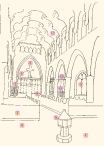
 |
  |
CHANTRY CHAPELS A chantry chapel is the term that designates
a private space, most frequently containing a tomb(s), for the saying of
masses for the deceased. At first only the nobility and clergy constructed
such spaces. Gradually wealthy merchants and other laity began to
claim these privileges. John Clopton (+ 1494) allocated a
considerable amount of the wealth that he acquired through the textile
trade to rebuilding the parish church of Long Melford (Suffolk), and donating
vestments, altarpieces, and alabaster sculpture. His family tombs
are in a chapel on the north aisle, and his own tomb and chantry chapel
adjacent. Set on the north (the dexter side) of the high altar, it
claims the most desirable space. The chapel once housed an altar
and other liturgical furniture and stained glass, now lost. Its wall
decoration, however, is relatively intact. One can see the Arms
of Clopton impaled with those of allied families and inscriptions of
verses by John Lydgate (+ c. 1450). Lydgate was a monk at Bury St. Edmunds
whose writings greatly influenced his time. John Baret, wealthy clothier,
who supported the reconstruction of the parish church St. Mary’s of Bury
St. Edmunds, set a precedent for Clopton’s patronage. Baret was buried
in 1467 in a specially constructed chantry chapel. He was a friend
and probably patron of the monk-poet, Lydgate.
9a Holy Trinity Church, interior Clopton Chantry 9b Holy Trinity Church, Clopton Chantry, detail of Clopton arms 9c Holy Trinity Church, interior Clopton Chantry, inscription with verses of the monk-poet John Lydgate on the Vine of Life Scroll |